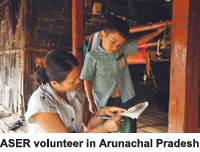 ASER 2010, compiled by the highly-respected Mumbai-based NGO Pratham, is the outcome of over 25,000 volunteers fanning out across 522 districts of rural India to assess actual learning outcomes of primary school children in 13,000 sample primaries countrywide. Published every year since 2005, ASER 2010 is a valuable status report on primary education in rural India and assesses the effectiveness of the Sarva Shiksha Abhiyaan (Education for All) initiative launched in 2001. Its major findings:
ASER 2010, compiled by the highly-respected Mumbai-based NGO Pratham, is the outcome of over 25,000 volunteers fanning out across 522 districts of rural India to assess actual learning outcomes of primary school children in 13,000 sample primaries countrywide. Published every year since 2005, ASER 2010 is a valuable status report on primary education in rural India and assesses the effectiveness of the Sarva Shiksha Abhiyaan (Education for All) initiative launched in 2001. Its major findings:
Enrolment
• 96.5 percent of children in the age group six-14 are enroled in school, cf. 93.4 percent in 2005.
• The percentage of out-of-school girls has declined from 11.2 percent in 2005 to 5.9 percent in 2010.
• Private school enrolment in rural India has increased from 16.3 percent in 2005 to 24.3 percent in 2010.
Reading ability
• Only 53.4 percent of children in class V can read class II level texts.
• Only 25.7 percent of children in class III can read class I level texts while a mere 18.8 percent of class III children can recognise alphabets.
Maths ability
• The percentage of children in class III who can complete two-digit subtraction sums has decreased from 39 percent in 2009 to 36.5 percent in 2010.
• Only 35.9 percent of children in class V can do simple division sums — dropping from 38 percent in 2009.
• Punjab has shown spectacular improvement in children’s math ability. For instance the percentage of children in class V who can do division sums has risen from 43.5 percent in 2008 to 69.8 percent in 2010.
Right to Education report card
Ss. 19 and 25 of the Right to Education Act, 2009, which became law on April 1 last year, stipulate ‘norms and standards’ all schools must upgrade to within three years of the Act coming into force. ASER 2010 assessed the RTE compliance of rural schools on the following parameters:
Pupil-teacher ratio
Half of all schools in rural India are in compliance with the RTE norms on pupil-teacher ratio i.e 1:30.
Infrastructure
• 75 percent of all schools have an office-cum-store
• 62 percent have play-grounds
• 50 percent of visited schools have a boundary or fence
• 90 percent of schools provide toilet facilities but they are usable in only half of them
• 70 percent of schools provide separate toilets for girls. However they are usable in only 37 percent of schools.
• 81 percent of schools are equipped with kitchens and 83 percent serve mid-day meals.
• 72 percent of schools provide drinking water to students.
Teacher and student attendance
• The percentage of primary schools (classes I-V) with all teachers present on the day of visit shows a consistent decline over three years, falling from 73.7 percent in 2007 to 69.2 percent in 2009 and 63.4 percent in 2010.
• Student attendance in rural schools is 73 percent — unchanged in the period 2007-10. However there’s considerable variation among the states.